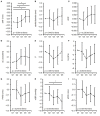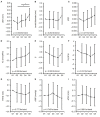Exercise Training Duration and Intensity Are Associated With Thicker Carotid Intima-Media Thickness but Improved Arterial Elasticity in Active Children and Adolescents
- PMID: 34307488
- PMCID: PMC8295565
- DOI: 10.3389/fcvm.2021.618294
Exercise Training Duration and Intensity Are Associated With Thicker Carotid Intima-Media Thickness but Improved Arterial Elasticity in Active Children and Adolescents
Abstract
Even though exercise generally has a positive effect on health, intensive exercise can have adverse effects on the vascular system of adults. This study aimed to investigate the association between training duration and intensity and vascular structure and function in 427 physically active children and adolescents (14.0 ± 1.94 years). In this study, we examined carotid intima-media thickness (cIMT), carotid diameter, and cIMT:diameter-ratio as parameters of carotid arterial structure and arterial compliance (AC), stiffness index β (β), elastic modulus (Ep), and carotid pulse wave velocity (PWVβ) as parameters of carotid arterial function with high-resolution ultrasound. We collected central systolic blood pressure (cSBP) and aortic pulse wave velocity (aPWV) as parameters of central arterial stiffness with an oscillometric device. We used the MoMo Physical Activity Questionnaire to record training duration and intensity. Training duration (p = 0.022) and intensity (p = 0.024) were associated with higher cIMT. Further, training duration was associated with lower central arterial stiffness (cSBP: p = 0.001; aPWV: p = 0.033) and improved AC (p < 0.001). Higher training intensity was related to improved AC (p < 0.001) and larger carotid diameter (p = 0.040). Boys presented thicker cIMT (p = 0.010), improved AC (p = 0.006), and lower central arterial stiffness (cSBP: p < 0.001; aPWV: p = 0.016) associated with higher training duration. Girls presented improved AC (p = 0.023) and lower Ep (p = 0.038) but higher β (p = 0.036) associated with higher training duration. Only boys demonstrated thicker cIMT (p = 0.016) and improved AC (p = 0.002) associated with higher training intensity. A quintile analyses of the training duration revealed thicker cIMT of children and adolescents in Q1 and Q5 than that in Q4 and Q5. Besides, Q1 showed lower cSBP compared to Q4 and Q5. Regarding training intensity, Q5 had thicker cIMT than Q2 and Q3. Although a higher training load is associated with thicker cIMT, the common carotid artery is also more elastic. This suggests that a higher training load leads to a functional adaptation of the carotid artery in youth.
Keywords: arterial elasticity; arterial stiffness; carotid intima - media thickness; exercise load; youth.
Copyright © 2021 Baumgartner, Weberruß, Engl, Schulz and Oberhoffer-Fritz.
Conflict of interest statement
The authors declare that the research was conducted in the absence of any commercial or financial relationships that could be construed as a potential conflict of interest.
Figures


Similar articles
-
Improved Carotid Elasticity but Altered Central Hemodynamics and Carotid Structure in Young Athletes.Front Sports Act Living. 2021 Mar 15;3:633873. doi: 10.3389/fspor.2021.633873. eCollection 2021. Front Sports Act Living. 2021. PMID: 33791599 Free PMC article.
-
Aortic arterial stiffness associates with carotid intima-media thickness and carotid plaques in younger middle-aged healthy people.Blood Press. 2024 Dec;33(1):2405161. doi: 10.1080/08037051.2024.2405161. Epub 2024 Sep 18. Blood Press. 2024. PMID: 39291635 Clinical Trial.
-
High Central Aortic Rather than Brachial Blood Pressure is Associated with Carotid Wall Remodeling and Increased Arterial Stiffness in Childhood.High Blood Press Cardiovasc Prev. 2017 Mar;24(1):49-60. doi: 10.1007/s40292-017-0179-2. Epub 2017 Jan 19. High Blood Press Cardiovasc Prev. 2017. PMID: 28101819
-
The relationship between telomere length and putative markers of vascular ageing: A systematic review and meta-analysis.Mech Ageing Dev. 2022 Jan;201:111604. doi: 10.1016/j.mad.2021.111604. Epub 2021 Nov 11. Mech Ageing Dev. 2022. PMID: 34774607
-
Vascular Structure and Function in Children and Adolescents: What Impact Do Physical Activity, Health-Related Physical Fitness, and Exercise Have?Front Pediatr. 2020 Mar 19;8:103. doi: 10.3389/fped.2020.00103. eCollection 2020. Front Pediatr. 2020. PMID: 32266183 Free PMC article. Review.
Cited by
-
Effects of obstructive sleep apnea on vascular structure and function in adults with obesity and type 2 diabetes: a comparative study.Cardiovasc Endocrinol Metab. 2025 Jul 30;14(3):e00342. doi: 10.1097/XCE.0000000000000342. eCollection 2025 Sep. Cardiovasc Endocrinol Metab. 2025. PMID: 40756182 Free PMC article.
-
Using Large Language Models to Enhance Exercise Recommendations and Physical Activity in Clinical and Healthy Populations: Scoping Review.JMIR Med Inform. 2025 May 27;13:e59309. doi: 10.2196/59309. JMIR Med Inform. 2025. PMID: 40424584 Free PMC article.
-
The association of physical activity and carotid intima-media-thickness in adolescents-data of the prospective early vascular ageing-tyrol cohort study.Front Pediatr. 2025 Feb 6;13:1527132. doi: 10.3389/fped.2025.1527132. eCollection 2025. Front Pediatr. 2025. PMID: 39981205 Free PMC article.
-
The MuCAYAplus Study-Influence of Physical Activity and Metabolic Parameters on the Structure and Function of the Cardiovascular System in Young Athletes.CJC Open. 2024 Sep 19;6(12):1549-1557. doi: 10.1016/j.cjco.2024.09.005. eCollection 2024 Dec. CJC Open. 2024. PMID: 39735949 Free PMC article.
-
Associations of Cardiovascular Health Metrics in Childhood and Adolescence With Arterial Health Indicators in Adolescence: The PANIC Study.J Am Heart Assoc. 2024 Nov 19;13(22):e035790. doi: 10.1161/JAHA.124.035790. Epub 2024 Nov 7. J Am Heart Assoc. 2024. PMID: 39508145 Free PMC article. Clinical Trial.
References
LinkOut - more resources
Full Text Sources
Miscellaneous

